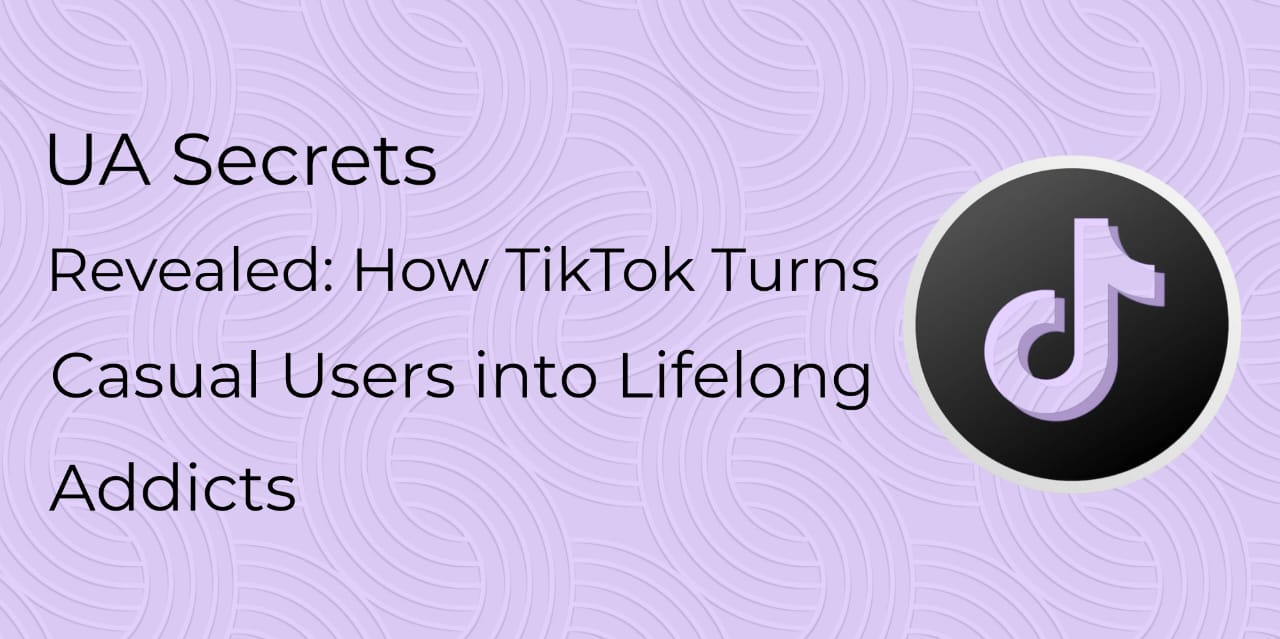In only a few short years, TikTok has become one of the dominant forces in the digital world. From an online home for lip-syncing videos to a global cultural phenomenon driving matters ranging from fashion trends to political movements, the changes are not an accident. But behind the laughs, dances, and viral challenges lies something more deliberate – a highly sophisticated User Acquisition (UA) strategy that transforms casual scrollers into lifelong, loyal users.
- The Psychology of Instant Gratification
The user experience is carefully engineered to fire off the brain’s dopamine reward system on TikTok. Every swipe brings a novel, unpredictable video – in other words, the possibility of humour, amazement, or surprise. This newness mimics the psychology of slot machines: people just keep swiping because they don’t know what comes next.
- Micro-rewards: Any video that makes a person laugh or, in some way, teaches something small brings in a micro-dose of dopamine.
- Variable reinforcement: Not every video is rewarding, but some are — and that inconsistency keeps you hooked.
- Effortless consumption: Unlike YouTube or Netflix, TikTok’s videos are short and don’t require much commitment. You don’t choose; you just scroll.
This trifecta keeps users in a loop of anticipation and satisfaction. The platform doesn’t just deliver content; it delivers continuous emotional stimulation.
- Hyper-Personalized Algorithms: The Heart of Addiction
The For You Page is the most advanced recommendation engine in social media right now, and TikTok’s algorithm collects data on literally every imaginable interaction:
- How long do you watch a video before swiping
- whether you rewatch it
- What kind of music plays
- The creators with whom you interact
Even your pauses and scroll speed
With this granular data, TikTok starts building a psychographic profile for every user in a matter of hours. It learns not only what you like but also how you feel. It then curates a stream of videos so precisely tailored to your interests that it feels like the app is reading your mind.
That’s what differentiates TikTok from competitors like Instagram Reels or YouTube Shorts, which rely heavily on who you follow. On TikTok, it’s what keeps you watching. You don’t need to follow anyone — the algorithm follows you.
Every swipe feels curated to you, and using the app seems irresistible and uniquely satisfying.
- Seamless User Acquisition Through Viral Loops
It doesn’t rely on ads as the sole means of growing its user base; instead, TikTok is built upon viral user acquisition loops: self-sustaining cycles of users attracting more users, perhaps without necessarily even trying to.
Here’s how it works:
- Creators make content that is funny, relatable, or emotionally charged.
- Viewers are watching and sharing videos on other platforms, such as Instagram, X (Twitter), or WhatsApp.
- The TikTok watermark ensures that every shared clip serves as free advertising.
- The curious viewers click the watermark, download TikTok, and begin to watch.
This natural cycle means every viral moment becomes a recruitment tool. But the growth of TikTok doesn’t feel forced; it feels organic, peer-driven, and real. The app grows not through traditional ads but through the cultural momentum of its own content.
- Gamified Growth and Creator Incentives
While casual users are hooked by content, creators are hooked by growth. TikTok’s UA strategy doesn’t stop at getting users to join; it encourages them to create, not just consume.
It gamifies creation by showing new users that they can go viral with ease, even without any followers. So, perhaps a first-time creator might put up a video and then see it reach thousands of views in hours. That early success is a trigger point for excitement and validation to make even more content.
Over time, TikTok balances this scale. It gives small creators just enough exposure to keep them hopeful while continuing to promote top creators to maintain engagement between communities. This system builds a powerful creator economy that drives retention, both for creators and their audiences. - The Illusion of Control: Choice Without Choice
One of the subtle psychological tricks of TikTok is how it continuously balances freedom and control. Users feel like they are in charge – swiping through an endless feed, choosing what to watch – but in reality, the algorithm decides everything.
When users think they’re choosing, they let their guard down. The illusion of control reduces cognitive resistance and enhances time spent in-app. Each interaction is turned into data for further optimisation, deepening the personalisation loop.
Even when users try to “take a break”, TikTok subtly re-engages them through:
- Notifications: “You have new videos from your favourites!”
- Trend-based push notifications: “This song is going viral — don’t miss it!”
- Social validation: “Your friend mentioned you in a comment.”
These nudges are not random; they are cleverly timed in accordance with the behavioural data. TikTok knows when you’re most likely to reopen the app – and it acts on that insight.
- Machine Learning Meets Emotion: Predictive Engagement
TikTok’s algorithm doesn’t simply respond to what users do; it predicts what they will do next. Using deep learning models, TikTok can recognise subtle emotional cues in viewing behaviour.
For example:
- If you stay on motivational videos, then TikTok will slowly introduce personal development content.
- You can rewatch the sad clips for emotional storytelling that will keep viewers engaged.
- It adjusts the timing and format of ads to reduce friction when ads are skipped too quickly.
This level of personalisation is so advanced that users often feel emotionally connected with the app. It understands their moods, passions, and curiosities better than they do. And that emotional bond is what turns casual users into lifelong ones.
- The Power of Sound and Trends
TikTok is sound-first, unlike other platforms. Music isn’t just background; it’s the virality engine. The algorithm promotes videos with trending sounds, making users want to jump on the bandwagon and use the same audio. There’s a kind of feedback loop:
- A song trends. →
- More users make videos with it.
- The algorithm promotes those videos →
- The trend amplifies. →
- The artist and TikTok both benefit.
This strategy fuels cultural and commercial success: songs from TikTok often top global music charts, and brands also incorporate sound trends into their marketing. The result: TikTok’s influence extends from the screen into mainstream culture – a powerful magnet in user acquisition.
- Paid UA Tactics: Smart Ads, Not Spam
While organic growth on TikTok is the stuff of legend, its paid UA efforts are equally strategic. Unlike intrusive ads on other platforms, TikTok Ads blend right into the For You Page as native content. They’re short, engaging, and visually aligned to organic videos.
TikTok’s ad platform uses interest-based targeting powered by real-time behaviour data. It doesn’t just know what users say they like; it knows what they show they like. This results in higher click-through rates and lower acquisition costs.
TikTok also conducts aggressive app install campaigns by offering incentives, such as rewards or bonus features, to new users. Combined with the influencer partnerships, this makes TikTok’s paid UA among the most efficient in the industry. - Community- and Identity-based Retention
Once users join, TikTok makes sure they stay. It’s not just about videos; it’s about belonging. Communities form around every imaginable niche, from BookTok to GymTok to PlantTok. These micro-communities give users a sense of identity and belonging.
By fostering those groups through algorithms and hashtags, TikTok converts engagement into social reinforcement. Users don’t just open the app to watch content – they open it to feel part of something bigger.
With constant feature updates, such as TikTok Shop, Live, and Stories, users find new reasons to engage. Each feature deepens the dependence, weaving TikTok into daily routine.
- The Long Game: Data as the Ultimate Asset
Every swipe, like, and share feeds into TikTok’s massive data ecosystem. This data doesn’t just improve recommendations; it shapes the global strategy of TikTok. The company leverages insights from user behaviour by using such information to:
- Optimize ad performance
- Test new features
- Improve onboarding experiences
- Predict cultural trends before they explode
In other words, data feeds an innovation feedback loop: the more people use it, the smarter TikTok gets; the smarter it gets, the more people it attracts and retains.
- Ethical Questions: Addiction or Engagement?
Where there is great power, there has to come great responsibility, too — and the way TikTok has honed the art of attention is debated worldwide. Critics say the platform’s design fosters digital addiction among younger audiences. The small doses of dopamine, constant notifications, and endless scroll rewire attention spans and shrink focus. Meanwhile, TikTok has “screen time limits” and reminders about “digital well-being”, but honestly, the app is designed to be addictive. Those features are like putting a speed bump on a racetrack. 12. Lessons for Marketers and Brands TikTok user acquisition secrets that all marketers should know: • Personalise relentlessly: The closer you align with user behaviour, the stronger the connection. • Create value loops: Encourage sharing and engagement that naturally expands reach.
- Community-building: Engage within niches and subcultures, rather than simply reach large audiences. • Make content native: Ads should feel like a part of the user experience, not an interruption. • Use data as a compass: Track real behaviour, not just vanity metrics. In all, TikTok’s playbook is a masterclass in data-driven empathy: it intuitively knows what users are craving and serves it up just at the right moment. Conclusion: From Casual Swipe to Lifelong Scroll TikTok’s rise isn’t accidental: it’s the result of a very well-thought-out ecosystem in which psychology, technology, and marketing all meet. It doesn’t just acquire users; it transforms them from the casual visitor into the loyal participant in this never-ending digital carnival.


